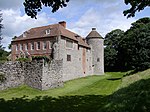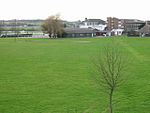Otterpool Quarry
Geological Conservation Review sitesQuarries in KentSites of Special Scientific Interest in Kent

Otterpool Quarry is a 10.2-hectare (25-acre) geological Site of Special Scientific Interest west of Hythe in Kent. It is a Geological Conservation Review site.This quarry exposes rocks dating to the Cretaceous period, and shows the contact between the Hythe and Sandgate beds. It is very rich in fossil ammonites, with species which can be correlated elsewhere.The site is private land with no public access. The quarry has been filled in and no geology is visible.
Excerpt from the Wikipedia article Otterpool Quarry (License: CC BY-SA 3.0, Authors, Images).Otterpool Quarry
Otterpool Lane, Folkestone and Hythe District
Geographical coordinates (GPS) Address Nearby Places Show on map
Geographical coordinates (GPS)
| Latitude | Longitude |
|---|---|
| N 51.088 ° | E 1.014 ° |
Address
Otterpool Lane
Otterpool Lane
TN25 6DB Folkestone and Hythe District
England, United Kingdom
Open on Google Maps







